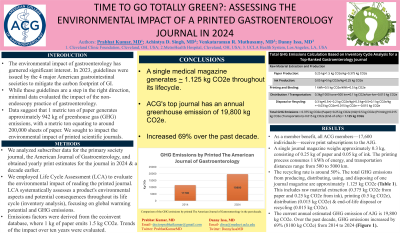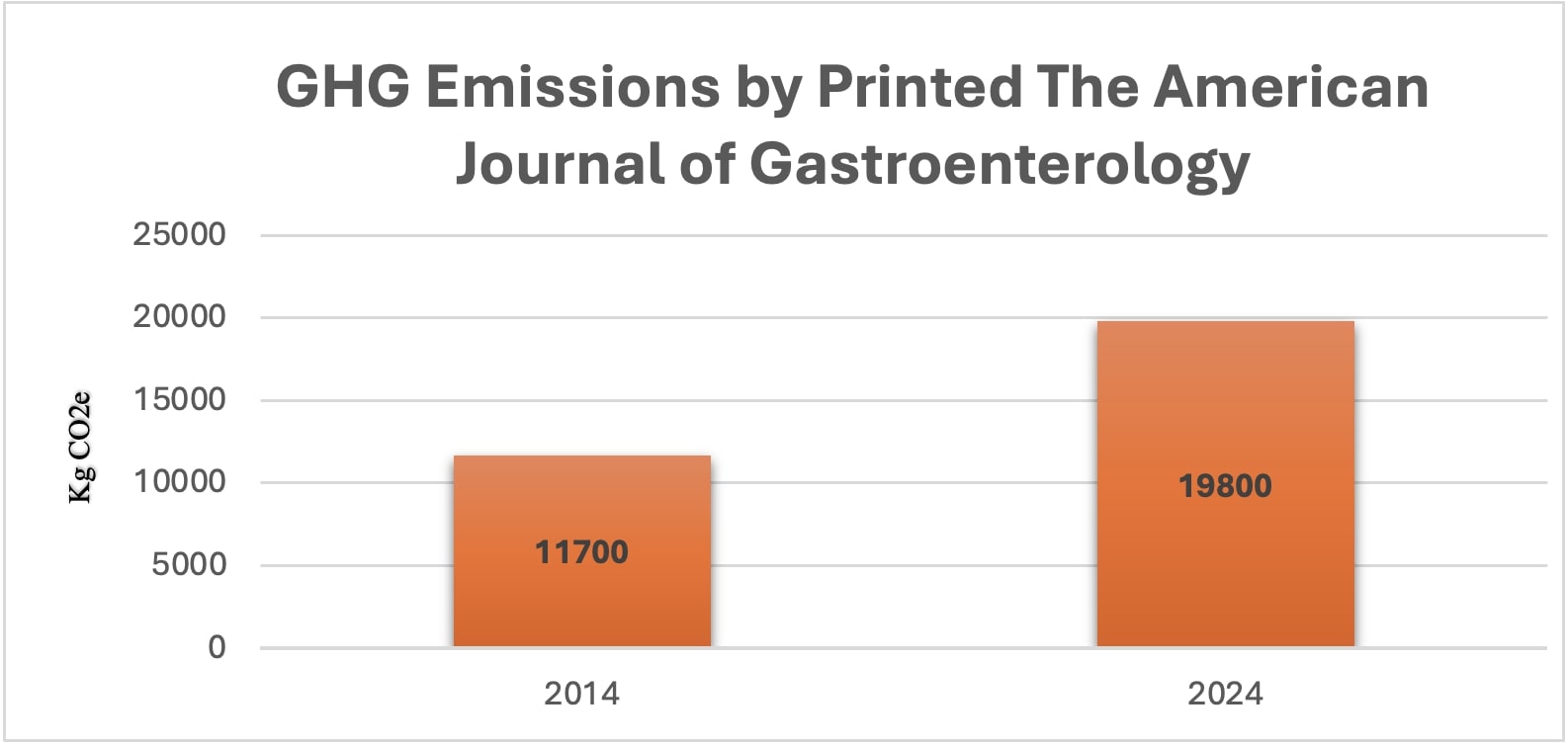Sunday Poster Session
Category: Practice Management
P1505 - Time to Go Totally Green?: Assessing the Environmental Impact of A Printed Gastroenterology Journal in 2024
Sunday, October 27, 2024
3:30 PM - 7:00 PM ET
Location: Exhibit Hall E

Has Audio

Prabhat Kumar, MD
Cleveland Clinic Foundation
Richmond, VA
Presenting Author(s)
Prabhat Kumar, MD1, Achintya D.. Singh, MBBS, MD2, Venkataraman R. Muthusamy, MD3, Danny Issa, MD4
1Cleveland Clinic Foundation, Cleveland, OH; 2Case Western Reserve University / MetroHealth, Cleveland, OH; 3David Geffen School of Medicine at UCLA, Sherman Oaks, CA; 4David Geffen School of Medicine at UCLA, Los Angeles, CA
Introduction: The environmental impact of gastroenterology has garnered significant interest. In 2023, guidelines were issued by the 4 major American gastrointestinal societies to mitigate the carbon footprint of GI. While these guidelines are a step in the right direction, minimal data evaluated the impact of the non-endoscopy practice of gastroenterology. Data suggest that 1 metric ton of paper generates approximately 942 kg of greenhouse gas (GHG) emissions, with a metric ton equating to around 200,000 sheets of paper. We sought to impact the environmental impact of printed scientific journals.
Methods: We analyzed subscriber data for the primary society journal, the American Journal of Gastroenterology, and obtained yearly print estimates for the journal in 2024 & a decade earlier. We employed Life Cycle Assessment (LCA) to evaluate the environmental impact of reading the printed journal. LCA systematically assesses a product's environmental aspects and potential consequences throughout its life cycle (inventory analysis), focusing on global warming potential and GHG emissions. Emissions factors were derived from the ecoinvent database, where 1 kg of paper emits 1.5 kg CO2e. Trends of the impact over ten years were evaluated.
Results: All ACG members, a total of 17,600 individuals, receive print subscriptions to the AJG as a member benefit. A single journal magazine weighs approximately 0.3 kg, consisting of 0.25 kg of paper and 0.05 kg of ink. The printing process consumes 1 kWh of energy, and transportation distances range from 500 to 5000 km. The recycling rate is around 50%. The total GHG emissions from producing, distributing, using, and disposing of one journal magazine are approximately 1.125 kg CO2e (Table 1). This includes raw material extraction (0.375 kg CO2e from paper and 0.25 kg CO2e from ink), printing (0.5 kg CO2e), distribution (0.015 kg CO2e) & end-of-life disposal or recycling (0.015 kg CO2e). The current annual estimated GHG emission of AJG is 19,800 kg CO2e. Over the past decade, GHG emissions increased by 69% (8100 kg CO2e) from 2014 to 2024 (Figure 1).
Discussion: A single medical magazine generates approximately 1.125 kg CO2e throughout its lifecycle. Our analysis of the ACG top journal estimates an annual GHG emission of 19,800 kg CO2e, with a 69% increase over the past decade. Further study is warranted across gastroenterology societies to examine the pros and cons of printed vs. online medical journals & innovate reliable and environmental-friendly alternatives.

Note: The table for this abstract can be viewed in the ePoster Gallery section of the ACG 2024 ePoster Site or in The American Journal of Gastroenterology's abstract supplement issue, both of which will be available starting October 27, 2024.
Disclosures:
Prabhat Kumar, MD1, Achintya D.. Singh, MBBS, MD2, Venkataraman R. Muthusamy, MD3, Danny Issa, MD4. P1505 - Time to Go Totally Green?: Assessing the Environmental Impact of A Printed Gastroenterology Journal in 2024, ACG 2024 Annual Scientific Meeting Abstracts. Philadelphia, PA: American College of Gastroenterology.
1Cleveland Clinic Foundation, Cleveland, OH; 2Case Western Reserve University / MetroHealth, Cleveland, OH; 3David Geffen School of Medicine at UCLA, Sherman Oaks, CA; 4David Geffen School of Medicine at UCLA, Los Angeles, CA
Introduction: The environmental impact of gastroenterology has garnered significant interest. In 2023, guidelines were issued by the 4 major American gastrointestinal societies to mitigate the carbon footprint of GI. While these guidelines are a step in the right direction, minimal data evaluated the impact of the non-endoscopy practice of gastroenterology. Data suggest that 1 metric ton of paper generates approximately 942 kg of greenhouse gas (GHG) emissions, with a metric ton equating to around 200,000 sheets of paper. We sought to impact the environmental impact of printed scientific journals.
Methods: We analyzed subscriber data for the primary society journal, the American Journal of Gastroenterology, and obtained yearly print estimates for the journal in 2024 & a decade earlier. We employed Life Cycle Assessment (LCA) to evaluate the environmental impact of reading the printed journal. LCA systematically assesses a product's environmental aspects and potential consequences throughout its life cycle (inventory analysis), focusing on global warming potential and GHG emissions. Emissions factors were derived from the ecoinvent database, where 1 kg of paper emits 1.5 kg CO2e. Trends of the impact over ten years were evaluated.
Results: All ACG members, a total of 17,600 individuals, receive print subscriptions to the AJG as a member benefit. A single journal magazine weighs approximately 0.3 kg, consisting of 0.25 kg of paper and 0.05 kg of ink. The printing process consumes 1 kWh of energy, and transportation distances range from 500 to 5000 km. The recycling rate is around 50%. The total GHG emissions from producing, distributing, using, and disposing of one journal magazine are approximately 1.125 kg CO2e (Table 1). This includes raw material extraction (0.375 kg CO2e from paper and 0.25 kg CO2e from ink), printing (0.5 kg CO2e), distribution (0.015 kg CO2e) & end-of-life disposal or recycling (0.015 kg CO2e). The current annual estimated GHG emission of AJG is 19,800 kg CO2e. Over the past decade, GHG emissions increased by 69% (8100 kg CO2e) from 2014 to 2024 (Figure 1).
Discussion: A single medical magazine generates approximately 1.125 kg CO2e throughout its lifecycle. Our analysis of the ACG top journal estimates an annual GHG emission of 19,800 kg CO2e, with a 69% increase over the past decade. Further study is warranted across gastroenterology societies to examine the pros and cons of printed vs. online medical journals & innovate reliable and environmental-friendly alternatives.

Figure: Comparison of the GHG emissions by printed The American Journal of Gastroenterology in the past decade.
Abbreviation: GHG, greenhouse gas
Abbreviation: GHG, greenhouse gas
Note: The table for this abstract can be viewed in the ePoster Gallery section of the ACG 2024 ePoster Site or in The American Journal of Gastroenterology's abstract supplement issue, both of which will be available starting October 27, 2024.
Disclosures:
Prabhat Kumar indicated no relevant financial relationships.
Achintya Singh indicated no relevant financial relationships.
Venkataraman Muthusamy: Boston Scientific – Consultant, Grant/Research Support. Capsovision – Stock Options, Stock-privately held company. Castle Biosciences – Consultant, Speakers Bureau. Endogastric Solutions – Advisory Committee/Board Member, Consultant, Speakers Bureau. Medtronic – Consultant. Pentax Medical – Consultant.
Danny Issa: Boston Scientific – Consultant, Speakers Bureau. Eli Lilly – Speakers Bureau.
Prabhat Kumar, MD1, Achintya D.. Singh, MBBS, MD2, Venkataraman R. Muthusamy, MD3, Danny Issa, MD4. P1505 - Time to Go Totally Green?: Assessing the Environmental Impact of A Printed Gastroenterology Journal in 2024, ACG 2024 Annual Scientific Meeting Abstracts. Philadelphia, PA: American College of Gastroenterology.
